 David M. Martín-Perea. Palaeobiology Department, National Museum of Natural Sciences - CSIC. Madrid, 28006, Spain; Geodynamics, Stratigraphy and Palaeontology Department, Faculty of Geological Sciences, Complutense University of Madrid, Madrid, 28040, Spain; IDEA - Institute of Evolution in Africa, University of Alcalá de Henares, Madrid, 28010, Spain. davidmam@ucm.es
David M. Martín-Perea. Palaeobiology Department, National Museum of Natural Sciences - CSIC. Madrid, 28006, Spain; Geodynamics, Stratigraphy and Palaeontology Department, Faculty of Geological Sciences, Complutense University of Madrid, Madrid, 28040, Spain; IDEA - Institute of Evolution in Africa, University of Alcalá de Henares, Madrid, 28010, Spain. davidmam@ucm.es
David M. Martín-Perea is a PhD candidate at the National Natural Sciences Museum in Madrid (Spain). His greatest interest as a researcher is the symbiosis between Taphonomy and Geoarchaeology, since the combination of the two disciplines provides excellent tools to analyze site formation.

 Ana Abrunhosa. Interdisciplinary Centre for Archaeology and Evolution of Human Behaviour, Faculty of Human and Social Science, Algarve University, Faro, 8005-139, Portugal; Archaeological Regional Museum, Alcalá de Henares, 28801, Spain. ana.abrunhosa@gmail.com
Ana Abrunhosa. Interdisciplinary Centre for Archaeology and Evolution of Human Behaviour, Faculty of Human and Social Science, Algarve University, Faro, 8005-139, Portugal; Archaeological Regional Museum, Alcalá de Henares, 28801, Spain. ana.abrunhosa@gmail.com
Ana Abrunhosa is an Archaeology PhD student at the University of Algarve / ICArEHB - Interdisciplinary Center for Archaeology and Evolution of Human Behaviour, collaborating with the Regional Archaeological Musem of Madrid Community (Spain). Her current work focusses on Neanderthal lithic raw material procurement strategies in the center of the Iberian Peninsula through the study of Pinilla del Valle sites (Madrid – Spain).

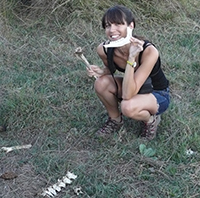 M. Soledad Domingo. Geodynamics, Stratigraphy and Palaeontology Department, Faculty of Geological Sciences, Complutense University of Madrid, Madrid, 28040, Spain; Experimental Sciences, Social Sciences and Mathematics Department, Faculty of Education, Complutense University of Madrid, Madrid, 28040, Spain. soldomingo@gmail.com
M. Soledad Domingo. Geodynamics, Stratigraphy and Palaeontology Department, Faculty of Geological Sciences, Complutense University of Madrid, Madrid, 28040, Spain; Experimental Sciences, Social Sciences and Mathematics Department, Faculty of Education, Complutense University of Madrid, Madrid, 28040, Spain. soldomingo@gmail.com
M. Soledad Domingo is an Assistant Professor at the Universidad Complutense de Madrid (Spain). Her field of study is mainly focused on the Neogene mammal record from Spain. Her lines of research include taphonomy, stable isotope palaeoecology and macroevolutionary studies. She obtained her PhD at the Universidad Complutense de Madrid (Spain) in 2009. In the course of her career, she has worked at different institutions that include the Museo Nacional de Ciencias Naturales-CSIC (Spain), the University of Michigan (USA), Saint Louis University-Madrid (Spain) and Estación Biológica de Doñana-CSIC (Spain). She has been Marie Sklodowska-Curie Fellow and a National Geographic Explorer.

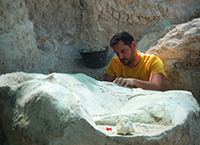 Enrique Cantero. Palaeobiology Department, National Museum of Natural Sciences - CSIC. Madrid, 28006, Spain. canteroycantero@hotmail.com
Enrique Cantero. Palaeobiology Department, National Museum of Natural Sciences - CSIC. Madrid, 28006, Spain. canteroycantero@hotmail.com
Enrique Cantero is a geologist and palaeontologist, specialized in the conservation of fossil remains. He is currently working at the National Natural Sciences Museum in Madrid (Spain), restoring Miocene mammal remains from the Batallones Butte sites.

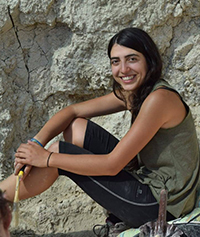 Iris Menéndez. Geodynamics, Stratigraphy and Palaeontology Department, Faculty of Geological Sciences, Complutense University of Madrid, Madrid, 28040, Spain; Sedimentary Geology and Environmental Change Department, Geosciences Institute - CSIC, Complutense University of Madrid, Madrid, 28040, Spain. irismene@ucm.es
Iris Menéndez. Geodynamics, Stratigraphy and Palaeontology Department, Faculty of Geological Sciences, Complutense University of Madrid, Madrid, 28040, Spain; Sedimentary Geology and Environmental Change Department, Geosciences Institute - CSIC, Complutense University of Madrid, Madrid, 28040, Spain. irismene@ucm.es
Iris Menéndez is a predoctoral researcher at the Universidad Complutense de Madrid (Spain) with special interest in macroevolutionary patterns and paleoecology. She applies phylogenetic and geometric morphometrics methods to study rodent diversification and morpho-ecological evolution.

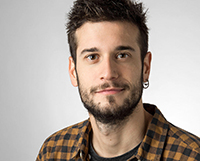 Fernando Blanco. Natural History Museum, Berlin, 10115, Germany. fblancosegovia@gmail.com
Fernando Blanco. Natural History Museum, Berlin, 10115, Germany. fblancosegovia@gmail.com
Fernando Blanco is a PhD candidate at Museum für Naturkunde and Humboldt University Berlin. Through the use of big data bases with phenotypic information, his research is focus on the Macroevolutionary and Macroecological process that shape the diversity of land mammals during Cenozoic.

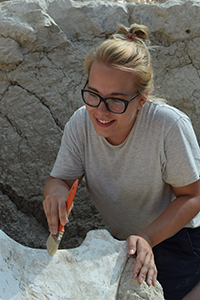 Patricia M. Carro-Rodríguez. Geodynamics, Stratigraphy and Palaeontology Department, Faculty of Geological Sciences, Complutense University of Madrid, Madrid, 28040, Spain; Sedimentary Geology and Environmental Change Department, Geosciences Institute - CSIC, Complutense University of Madrid, Madrid, 28040, Spain. patcarro@ucm.es
Patricia M. Carro-Rodríguez. Geodynamics, Stratigraphy and Palaeontology Department, Faculty of Geological Sciences, Complutense University of Madrid, Madrid, 28040, Spain; Sedimentary Geology and Environmental Change Department, Geosciences Institute - CSIC, Complutense University of Madrid, Madrid, 28040, Spain. patcarro@ucm.es
Patricia M. Carro Rodríguez is a Ph.D. student on Evolutionary Biology developing her thesis dissertation at Universidad Complutense de Madrid (Spain). Her studies are focused on the morphometric, diversity, and evolution of the fossil record of cricetids during the Miocene of Europe. Within these studies, it stands out the rodent fossil record of the Late Miocene site Cerro de Los Batallones (Madrid, Spain).

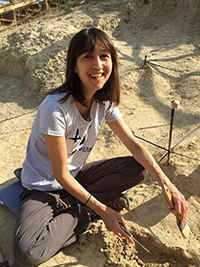 Laura Domingo. Geodynamics, Stratigraphy and Palaeontology Department, Faculty of Geological Sciences, Complutense University of Madrid, Madrid, 28040, Spain; Sedimentary Geology and Environmental Change Department, Geosciences Institute - CSIC, Complutense University of Madrid, Madrid, 28040, Spain; Earth and Planetary Sciences Department, University of California Santa Cruz, Santa Cruz, California, 95064, USA. lauradomingo@geo.ucm.es
Laura Domingo. Geodynamics, Stratigraphy and Palaeontology Department, Faculty of Geological Sciences, Complutense University of Madrid, Madrid, 28040, Spain; Sedimentary Geology and Environmental Change Department, Geosciences Institute - CSIC, Complutense University of Madrid, Madrid, 28040, Spain; Earth and Planetary Sciences Department, University of California Santa Cruz, Santa Cruz, California, 95064, USA. lauradomingo@geo.ucm.es
Laura Domingo is an assistant professor at the Geodynamics, Stratigraphy and Palaeontology Department at the School of Geological Sciences from the Complutense University of Madrid (Spain) and an associate researcher at the Earth and Planetary Sciences Department from the University of California Santa Cruz (USA). Her research interests are focused on the investigation of past environmental and climate variability and ecological traits by means of biogeochemical analyses on geological and paleontological archives. She is a specialist on stable isotope biogeochemistry of Mesozoic and Cenozoic vertebrates, invertebrates and organic matter enclosed in the sediment. She has worked on the geological and paleontological record of Spain, Argentina, Chile and USA. She is the director of the Somosaguas fossil site (Madrid Basin, Spain) and is very active at communicating science to the general public as well as at encouraging the access to STEM studies among girls and young females.

 Manuel Hernández Fernández. Geodynamics, Stratigraphy and Palaeontology Department, Faculty of Geological Sciences, Complutense University of Madrid, Madrid, 28040, Spain; Sedimentary Geology and Environmental Change Department, Geosciences Institute - CSIC, Complutense University of Madrid, Madrid, 28040, Spain. hdezfdez@ucm.es
Manuel Hernández Fernández. Geodynamics, Stratigraphy and Palaeontology Department, Faculty of Geological Sciences, Complutense University of Madrid, Madrid, 28040, Spain; Sedimentary Geology and Environmental Change Department, Geosciences Institute - CSIC, Complutense University of Madrid, Madrid, 28040, Spain. hdezfdez@ucm.es
Manuel Hernández Fernández has broad interests in the area of evolutionary biology and a wide variety of problems related to the biological and climatic evolution of the Neogene-Quaternary Earth, particularly in the interface between macroecology and palaeoclimatology. He is a full professor at the Palaeontology Area of the Complutense University of Madrid and has headed the excavations and research group of the Somosaguas fossil site since 2010.

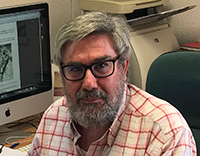 Jorge Morales. Palaeobiology Department, National Museum of Natural Sciences - CSIC. Madrid, 28006, Spain. mcnm166@mncn.csic.es
Jorge Morales. Palaeobiology Department, National Museum of Natural Sciences - CSIC. Madrid, 28006, Spain. mcnm166@mncn.csic.es
Jorge Morales is a senior researcher at the Paleobiology Department of the Museo Nacional de Ciencias Naturales-Consejo Superior de Investigaciones Científicas, Madrid (Spain). During his extensive paleontological career, he has dealt with the study of a wide arrange of fossil mammal groups from the Neogene of the Iberian Peninsula, as well as Africa. He has also headed the excavations and research group of the Cerro de los Batallones fossil site since 1991. His most recent studies include the palaeobiology and functional anatomy of fossil Carnivora as well as ruminant evolution.

